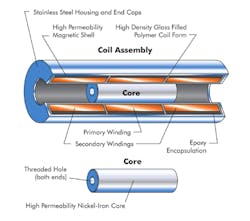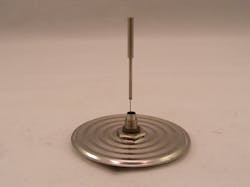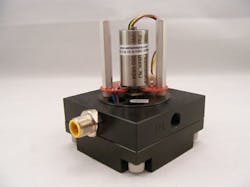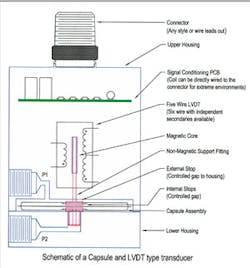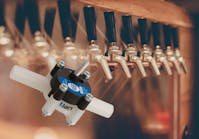From its limited use in providing laboratory measurements at the beginning of World War II to its broad implementation in an array of industrial, research and military applications today, the LVDT (linear variable differential transformer) has evolved into a cost-effective, diverse, and highly reliable linear measurement device.
Today the modern LVDT, or linear position sensor, can be found under water, in the ground, and even in the air serving as an incremental feedback device.
What Is an LVDT?
The LVDT is an electromechanical transducer that can convert the rectilinear motion of an object to which it is coupled mechanically into a corresponding electrical signal. The basic concept of the technology (Figure 1) has remained the same since its inception over six decades ago. The LVDT produces an electrical output signal directly proportional to the position of a physically separate movable iron ferrous core. Its operating principle is the same as any transformer where a primary coil induces voltages in secondary coils, coupled only by electromagnetic lines of force, with no need for any physical contact among any element. No physical contact – therefore no friction or wear.
A New Generation of LVDT Technology
New construction materials, manufacturing techniques, and low-cost microelectronics have revolutionized the LVDT into a more reliable and cost-effective technology that is capable of measuring movements as small as a few millionths of an inch up to +/-20 inches (+/-0.5 m).
In the past, electronics necessary to operate the LVDT properly were both complicated and expensive, prohibiting widespread use of the technology. Powerful, low-cost microelectronics and microprocessors have brought the cost of using LVDTs to very attractive levels while significantly enhancing performance. In fact, the price of linear position sensors has actually decreased in some instances while performance and accuracy improved.
Elimination of External Electronics
High-density microelectronics also enable the incorporation of signal conditioning and processing functions inside the LVDT housing rather than requiring an external box. Typically, AC-operated LVDTs needed a separate signal conditioner to provide useable output. Time spent calibrating both components in addition to the cost of additional equipment amplified the piece price of a single LVDT.
Using ASIC and microprocessors, LVDT technology now incorporates internal electronics, providing for more complex processing functions, as well as signal conditioning within the sensor housing. Sensor manufacturers can now embed more control into the sensor housing while keeping the overall package size small. DC-operated LVDTs also can produce digital outputs directly compatible with computer–based systems and standardized digital buses, which is a desirable characteristic for metrology applications.
For applications requiring an AC-operated sensor and separate electronics, push-button zero and span controls and improved software reduce the time and expense associated with calibration.
Better Performance
New construction materials and manufacturing techniques, combined with ASIC and microprocessors, have enabled LVDTs to achieve better performance (as much as 10x in some cases) than LVDT technology of 10 or 20 years ago. Errors caused by the sensor’s own characteristics or environment can be corrected to produce a significantly more accurate LVDT. While a standard LVDT can possess a linearity of +/-0.25 percent of full-scale output, a corrected LVDT with microprocessing can linearize its output to +/-0.05 percent of full-scale output.
Smaller Strokes & Smaller Diameters
Strokes of traditional LVDT linear position sensors that were once too long for applications with limited space are no longer an issue. New computerized winding techniques and smaller embedded microprocessors have considerably reduced the length of the linear position sensor body compared to its measurable stroke length. Today’s modern LVDTs are up to 80 percent more compact for any given stroke. In fact, for short-stroke actuators and cylinders (less than six inches) where a magnetostrictive sensor was the preferred method of measurement, some linear position sensors can now be much shorter.
Lightweight cores also boost dynamic response and reduce weight. A unique coil winding configuration supports a compact diameter design, enabling the LVDT linear position sensor to serve as an integral part of devices with tight space restrictions.
New Construction Options Offer Resistance to Different Environments
With new construction material options, LVDT technology can be built to perform reliably and over time in hostile environments with high and low temperature extremes, radiation exposure, and vacuum pressure conditions where less reliable technology had been used.
For example, when hermetically sealed and constructed from Inconel 718, LVDT technology possesses greater pressure and chemical resistance to perform reliably under very hostile chemical conditions, even in seawater and corrosive acids.
Monel 400, a special nickel-based alloy, provides excellent resistance against pitting and attack by microorganisms, enabling LVDTs to be specified for use in shallow and warm waters with high levels of oxygen. And Titanium and Hastelloy options provide LVDT technology greater resistance to pressure and corrosion when measurements must be obtained in seawater depths down to 7,500 ft. and with an external pressure of approximately 3,800 PSI.
Exotic alloys, such as cobalt, nickel, and chromium, allow the LVDT to perform in sulfidation environments in the presence of high levels of H2-H2S concentrations and high temperatures up to 425 C. All these different material options open new doors for the use of LVDTs in different applications.
Sensor In a Sensor
Highly customized packaging, high performance, and low cost make the LVDT very attractive for many cutting-edge applications. An innovative use of LVDT technology is its incorporation into a pressure sensor body. As recent iterations of LVDT technology have evolved to operate in a wide range of corrosive materials, radiation, and temperatures without any oil filling and bulky sealing systems, the LVDT eliminates the need for configuring pressure sensors with expensive valves and fluid-filled remote seals for protection against corrosive media, radiation, and/or extreme media temperature ranges when operating in demanding environments. The pressure sensor also gains the LVDT’s natural attributes of friction-free operation, environmental robustness, and unlimited mechanical life (see sidebar on page 26).
New Differential Pressure Sensor Incorporates LVDT Technology to Create More Environmentally Resistant and Economical Pressure Sensor
Differential-pressure (DP) sensors with electronic signal processing are increasingly being used to monitor flow, filter condition, and level. Since these devices offer linear and accurate output, they are also replacing differential-pressure switches that only support on-off conditions and are useless for closed-loop control systems.
These DP sensors are often configured with expensive valves and fluid-filled remote seals for added protection against corrosive media, radiation, and/or extreme media temperature ranges when operating in demanding environments. In cold ambient environments, especially operating in temperatures below -4 F (-20 C), the sensors need to be heated either by trace heater or within a heated enclosure to maintain the operation of the DP sensor. In addition to being expensive, these valves and seals tend to be bulky and require time to install and maintain. In many critical applications, such as food and pharmaceuticals, filled fluids are a serious concern due to process contamination. In gaseous systems, such as hydrogen and oxygen and semiconductor applications, fluid-filled sensors are being banned since potential leakage of fluid into a process could cause an explosion or other serious safety issues.
Recent iterations of LVDT (linear variable differential transformer) technology have evolved to operate in a wide range of corrosive materials, radiation, and temperatures without any oil filling and bulky sealing systems. By encapsulating proven LVDT technology with digital compensation, current-generation pressure sensors are capable of combining the benefits of friction-free operation, environmental robustness, and unlimited mechanical life. By selecting the diaphragm thickness and material properties, Table 1 shows the dP ranges that can be produced using the LVDT technology.
Very-Low-Range DP Sensor
In this design, a bellow is used for measuring very low pressures from five inches H2O (inches of water column) to one PSID with line pressures up to 200 PSI. The bellow is constructed from a thin, 0.002” thick (twice the thickness of an equivalent oil-filled sensor) section of nickel alloy, usually Ni-span C, which offers good thermal behavior with low hysteresis and repeatability. The LVDT core, made from medium permeability material, such as 52 Alloy, is attached to the bellow. As the bellow moves with applied pressure, the LVDT provides a linear signal that can be unidirectional or bidirectional, subject to the application.
The LVDT is driven from 3V, 10kHz source for the electronics board. This signal processing PC board accepts 10-32 VDC, unregulated supply voltage and outputs either a 0-5 V or 4-20 mA output signal, as needed. While the core is in the middle of the LVDT, the output from the electronics can be programmed to be zero V or four mA. As the diaphragm moves, the core transfers more magnetic flux into one of the secondary coils than the other. As a result, the output signal will change. Hence, by applying pressure and temperature to the assembly during calibration, the zero and span values can be calibrated from 4 F to 160 F (-10 C to 70 C). The dual-channel ASIC takes data from the LVDT and temperature source before applying the polynomial correction coefficients to curve fit for error correction. Figure 2 shows device construction.
Low- & Medium-Range DP Sensor
The low-range DP covers from 1 PSID to 5 PSID in 500 PSI line pressures, while the medium range covers 10 PSID and 50 PSID with line pressures up to 1,500 PSI and 5,000 PSI, respectively. These sensors utilize a thick-stamped corrugated diaphragm with no bellows. The LVDT and signal processing electronics are the same as used in the very-low-range DP sensor. In normal operation, the diaphragm is free to move up and down with applied pressure. However, in case of overload or high pressures, the diaphragm will bottom out and sit against the over-travel stops in both directions. The design of the over-travel stops is critical and must support the diaphragm fully.
In comparison to the very low pressure DP sensor, the P1 and P2 pressure ports are reversed for this device to function properly. In case of high or very cold media or radiation, the electronics can be remotely located away from the sensor head without the loss of performance.
Karmjit S. Sihdu is vice president of business development and co-founder of American Sensor Technologies, Inc. He has over 25 years experience in pressure- and position-sensing sales and engineering. Mr. Sidhu is currently completing his Ph.D. in Material Science. He can be reached at [email protected] or 973 448-1901.
